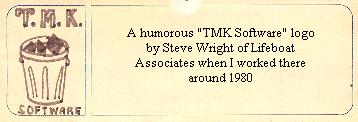
The outside of the cabinet, with a keyboard and monitor to the right. Further to the right, you can see the output tray of the HP LaserJet 5SiMX printer. Behind the monitor and cabinet, you can see a large air conditioner peeking out. With the 100+ degree days we had in the summer of 1999, this came in very handy.
A view of the top section of the cabinet, from the front. At the top, you can see the cooling fan (an environmental sensor is located behind the fan). Below them is a Cisco 2924M 10/100 Ethernet switch that distributes the network inside the cabinet (and to the HP laser printer mentioned above). Below that is a DECserver 700 (terminal server) which is connected to the console port of each device for out-of-band management. Next is a DEC Alpha DS10 server with 256MB of RAM and 2 9GB internal hard disks. It also has a CD-ROM and floppy. This system is a VMS FTP server - ftp://ftp2.glaver.org. Below that system is another identical Alpha, server.glaver.org, which has a 96GB Seagate autoloader added. This system is my main VMS system and is also used as a staging area for Unix backups (they're backed up from the Unix systems to the 9GB disk and then to the tape drive). Next is an APC AP9210 remote power controller. It handles the power sequencing for the devices above it in the cabinet. It's really cute - it has web, telnet, and SNMP interfaces as well as a serial port. Near the bottom of the picture is the overly colorful keyboard/video/mouse (KVM) switch from Rose Electronics. It provides on-screen display, control, and switching between the various systems in this cabinet (and 2 remote systems) on the attached keyboard/monitor/mouse. The system below the KVM switch is a Unix server which will be described in more detail below.
Moving down the front, we see developer.glaver.org, a dual PPro 200/512 system w/ 512MB of main memory. It has disks further down, which we'll discuss below. It runs BSDI's BSD/OS 4.1. It's used for software development and testing (it's a full-source system). Next is gate.glaver.org, which is my main Unix box (and also the web server for these pages). It has an identical processor/memory/OS config, but talks to a 51GB RAID array for its disks. Below this are the disks - the array for gate on the left, and a DAT drive, hard disk, and CD for developer.
This is a view of developer.glaver.org with its cover off, as I was finishing assembling it. Note the sticker on the front (visible when the front door is open for floppy access) detailing what is in the system. This makes it very easy to keep track of what's where.
This picture shows the innards of the system. On the top left is the power supply. The odd-looking gadget on the right edge of the power supply is a 110 Alert from PC Power & Cooling which will sound an alarm if the system overheats. To the right of the power supply, on the motherboard are the dual Pentium Pro CPUs, under their Dual CPU-Cool fans (also from PC Power & Cooling). Toward the bottom of the picture are the 4 128MB SIMMS. The motherboard is a Tyan S1662D. The expansion cards are a DEC DE500-BA Ethernet, a BusLogic BT-948 SCSI controller, and a no-name (Jaton) PCI VGA. For some reason, the Tyan board runs very slowly with ISA VGA cards.
Since this photograph was taken, the SCSI and Ethernet cards have been replaced by an IntraServer ITI-4280UE card, which provides 2 independent Ultra Wide SCSI ports and a DEC-compatible Ethernet, all on a single card. The video card was changed to a Number 9 Vision 330 so it runs better under X Windows.
In this view of the bottom of the front, we see the RAID array, tape/disk/CD mentioned above, as well as the second APC AP9210 power controller and an APC SU3000RM3U UPS. Also visible is a "zip strip" on the right rear side of the cabinet, which I use to organize the internal cables.
This view of the back shows the rear of the AlphaStations. Note the neatness of the KVM cabling - a single cable from the switch box ends at each system's video connector and then two "tails" (one for the keyboard and one for the mouse) extend to those connectors.
Next, we can see the back of the power controller, keyboard/video/mouse switch, and one of the Unix boxes.
Near the bottom of the back, we can see the cabling on the RAID array, as well as a NetGear network disk drive.
At the bottom of the back, we can see power cabling from the UPS. The box at the upper left of the picture is the Ethernet adapter for the UPS (the internal slot on the UPS is occupied by the temperature/humidy probe's controller).









